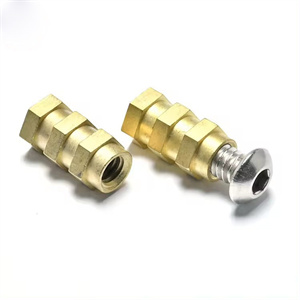The machining of internal threads is a common and important manufacturing process. There are several main methods for machining internal threads:
Tapping:
This is a commonly used method for machining internal threads. Using a tap, rotate and push along the prefabricated hole using manual or electric tools to cut the internal thread. Suitable for processing smaller diameters and not too deep internal threads. For example, machining internal threads for fixing screws on the casing of electronic devices.
Turning:
On a lathe, special cutting tools are used to turn internal threads. Can process larger diameter and high-precision internal threads. For example, machining internal threads at the shaft end of large mechanical components.
Thread milling:
Use a thread milling cutter to mill internal threads on a CNC machine tool according to a specific trajectory. It has advantages in processing difficult to machine materials and complex internal thread shapes.
When machining internal threads, attention should be paid to the following points:
The size and accuracy of prefabricated holes. If the diameter of prefabricated holes is too small, it will cause difficulties in tapping or cutting, while if it is too large, it will affect the fitting accuracy of the thread.
The selection of cutting parameters, including cutting speed, feed rate, and cutting depth, should be determined based on materials, thread specifications, and machine performance to ensure machining quality and efficiency.
Cooling and lubrication help reduce cutting temperature, reduce tool wear, and improve thread surface quality.
The selection and maintenance of cutting tools require selecting suitable tools for different materials and thread specifications, and regularly inspecting and replacing worn tools.
In the aerospace field, the internal threads of some key components require extremely high precision and quality, and advanced CNC thread milling technology is usually used for processing. In general mechanical manufacturing, tapping may be a more economical and efficient choice for some ordinary specifications of internal threads. The machining of internal threads requires comprehensive consideration of multiple factors, selecting appropriate machining methods and process parameters to meet different application requirements.
CNC machining, also known as Computerized Numerical Control Machining, is a technology that uses CNC machine tools to process materials. CNC machine tools are programmed and controlled by CNC machining language, usually G code. This code language can tell the machining tool of the CNC machine what Cartesian position coordinates to use, and control the feed rate and spindle speed of the tool, as well as the functions of the tool converter and coolant.
CNC machining has many advantages over manual machining, such as the ability to produce very precise and repeatable parts, and the ability to process parts with complex shapes that cannot be completed by manual machining. In addition, CNC machining technology has been widely promoted, and most machining workshops have CNC machining capabilities. Common CNC machining methods include CNC milling, CNC turning, and CNC EDM wire cutting (electric discharge wire cutting).
The application fields of CNC machining are very extensive, including but not limited to medical device manufacturing, mold manufacturing, aerospace, electronic equipment manufacturing, and mechanical parts manufacturing. In these fields, CNC machining can improve production efficiency and product quality, meeting the machining needs of high-precision and complex shaped parts.
When performing CNC machining, it is necessary to pay attention to some operating norms and safety precautions, such as performing a three-axis zero point reset when starting up, checking whether the machine’s guide rail oil, spindle hydraulic oil, etc. are sufficient, the dimensions of the processed workpiece should correspond to the drawings, and resetting the XYZ axis to zero when changing tools. Meanwhile, tool alignment is a necessary skill in CNC machining, and forgetting to align the tool is a dangerous operation that can lead to serious consequences.
